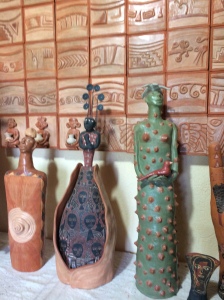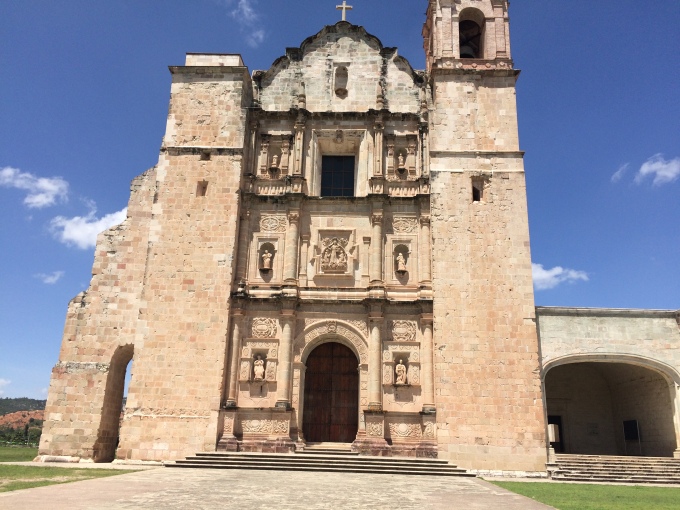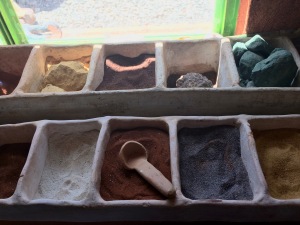I had only been to Yanhuitlán (yahn-wheat-lahn’) three years ago on a Good Friday expedition, so when a friend told me about a fantastic field trip to the home studio of famous ceramic artists, I put it on my “to do” list. Wanting to do something special on the Fourth of July – not only U.S. Independence Day but the day my dad died in 2000 — I vowed to make it finally happen.


The artists’ home/studio courtyard
Nothing that sounds simple to arrange is ever simple in Mexico, so it took a week of emailing ceramic artist Manuel Reyes, whose wife, artist Marisela Guzman, actually answered with details and directions. The directions read: “Aldama street with no number, on the side of the Calvario church, adobe house with a white car out front.” There was another flurry of activity and emails from the four of us gal pals going, trying to arrange a driver for the one-and-a-half hour trip each way in a private car, since the bus route would only get us to Nochixtlán (no-cheece-tlan’) and we’d have to take a taxi-collectivo the 20 or so miles beyond on the old highway through the mountain

Ceramics by Manuel Reyes
Private driver and guide Antonio (though we didn’t need his guide skills, just the car), who Suzanne found at a promised price of $250 or $12.50 US per hour), is impressively right on time to pick us up in his white Honda Civic in front of Suzanne’s house, the most centrally located of all of us on Pino Suarez, just south of the Oaxaca Lending Library. I get to ride shotgun, Suzanne, Liduina and Gail in back, just a tiny bit squeezed since we’d foregone the larger van for the cost.
The day is breathtakingly beautiful, with a crispness to the air and luminosity to the light that happens in early summer in the mountains when rainy season has just begun. The cuota (toll road) to Nochixtlán cuts through red dirt hills with lightly green vegetation; it hasn’t rained all that much yet but at least they aren’t dry and brown as they were just a few weeks ago.

At the Nochixtlán cut-off, we turn left up into the mountains on the old road and from several miles away can spot the huge silhouette of the Yuanhitlán church, officially the Templo y Ex-Convento de Santo Domingo de Guzmán.

The church’s interior
Since we have a half hour or so to spare before our appointment at the Reyes studio, having factored in the very real possibility that our driver wouldn’t show up on time, we stop to see the church, begun in 1541 by Dominicans who left an open field in front for proselytizing 15,000 indigenous people that they hoped to convert. The space is stunning, the height mind-boggling thinking of scaffolding and laying huge blocks of stone with no cranes, the altar over-the-top gilded and adorned in this small, poor town in the dusty hills. The original 16thcentury pipe organ looms over the sanctuary from upstairs, still working and played in concert several times a year.

Stairstep flying buttresses and a field to hold 15,000 of the indigenous Mixtc people
But our mission being the studio of ceramic artist Manuel Reyes and his wife, equally renowned ceramic artist Marisela Guzman, we decide to leave the attached museum in the ex-convent for later and head to our art demonstration and lunch appointment. Directions being better by description – their studio is by the other church in town, the metal domed Calvario — we had a 50% chance of picking the right “side” of the church, which we didn’t at first. Antonio calls Marisela, who comes out front and waves to us from the other side, and we move the car around to their house.

Manuel’s homage to pre-Hispanic pottery, missing a piece by accident, not plan
Manuel meets us at the front door; he’s a handsome, broad-faced guy whose ponytail is just showing a few gray streaks. His and Marisela’s house is an art studio that they happen to live in, walls stacked with the paintings and ceramic works he began with before he started creating more ceramic figures just six years ago. One piece features squares of ceramic background, each with a small shard of real antique pottery gathered from neighboring archeological sites (try that in the US). I wonder about the significance of one empty square, expecting a philosophical answer of sorts. “Oh, that one fell off,” laughs Manuel, “and I haven’t had a chance to glue it back on!”

Marisela Guzman, an artist in her own right, making lunch for us in their home
Meanwhile, Marisela – a renowned ceramic artist in her own right – is stirring the ingredients for a chicken lasagna stuffed with zucchini flowers, mushrooms and poblano peppers. Later, when I saw the depth and breadth of her art – ceramic figures of mothers with children, peasants and animals bordering their skirts, lovers intertwined – I felt bad that we hadn’t asked her more about her own artwork, which is showcased in the main church museum.

Their courtyard is a magical place, a small rectangle of bright adobe walls, ceramic heads and figures, a shelf lined with whimsical animals created by students, the house chihuahua whining softly from the balcony overhead, surrounded by ceramic heads. A man painted reed-bottomed chairs to one side.

Manuel’s studio is a sensory-overloading space of work room, jars of paintbrushes, trays of the different colored dirt he paints with, and a shelf stuffed with hundreds of CDs (playing: jazz artist Sandra Crow, who died just a couple of weeks ago). His work includes interpretations of pre-Hispanic art painted in natural earth tones – including an astonishing green from the nearby hills – smiling dogs, paired lovers who fit together like gloves, flying men suspended from the ceiling by string. His ceramics are fired at high temperatures in a gas kiln, unlike the lower-temperature wood-fire kilns used in the area.

Local earth used as painting pigment

One of these is not like the others

Demonstrating dirt pigments
It’s a magical afternoon, Manuel demonstrating his painting and pigment-mixing techniques, burnishing an unfired clay pot with an agate stone, jazz playing, the smell of paint and sizzling vegetables a heady mix. There is local mezcal to start with as we all choose a little something to buy from Manuel (alas, my budget doesn’t extend to his work beyond a clay stamp of a pre-Hispanic dog still splashed with green paint and a smiling, spotted toro created by one of his students).
Marisela’s lasagna is delicious; their teenage daughter and primary school-aged son join us and smile kindly at our splotchy Spanish, which is after all good enough. (I am able to comment to Manual how fortunate he is to make a living doing what he loves, and how sometimes emotion transcends actual language, as in the music of Portugese singer Cesaria Evora, whose music makes us both cry without being able to understand the lyrics).

Our gang of four gringas, with Manuel, Marisela, their kids and dog

Column detail at the church
The studio visit is over; driver Antonio takes a group photo out front. We head back to the ex-convento museum, which features several of Marisela’s pieces in the downstairs gallery, and wander through the upstairs, which includes a sixteen-stall nuns’ latrine, four-square with privacy partitions. We’re all tired and fairly quiet on the ride back to Oaxaca City, digesting the momentous feel of the day.
It’s a damn fine way to have spent the Fourth of July.

Not staged; just the sanctuary guard’s hat left respectfully outside the massive front door

View looking out from the church’s front door, complete with sleeping dog
–Susan Bean Aycock, Embracing the Chaos
So I just noticed that my last blog, Fun on the Fourth of July, was written exactly a year ago with radio silence since then. Health problems and apartment moves (both countries) are so not fun and so time consuming. I count my years not by the calendar but by birthdays, and I’ve got one coming up in August — here’s hoping for a more healthy, grounded and literary year ahead. With more fun field trips, of course.

One thought on “Yanhuitlan, Second Verse with Ceramics”